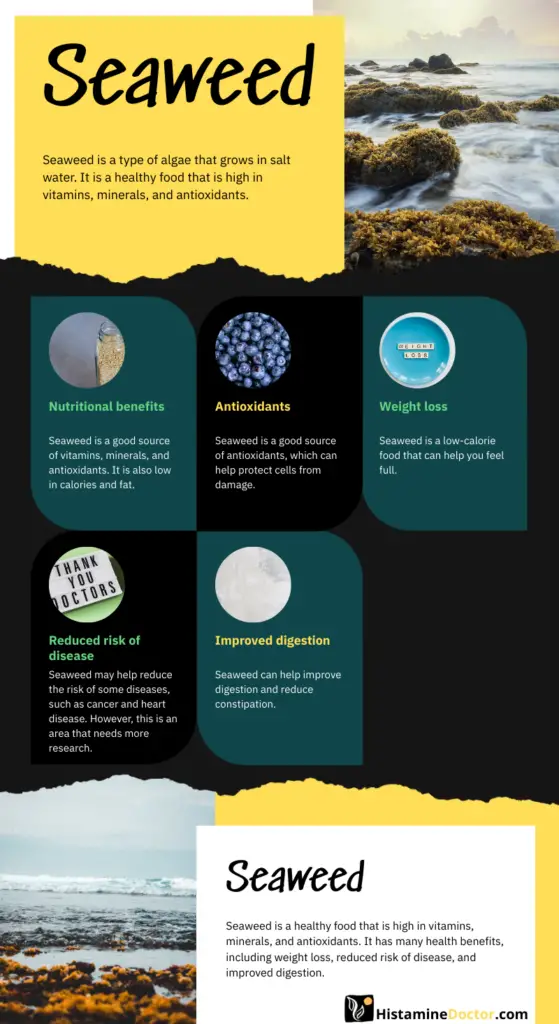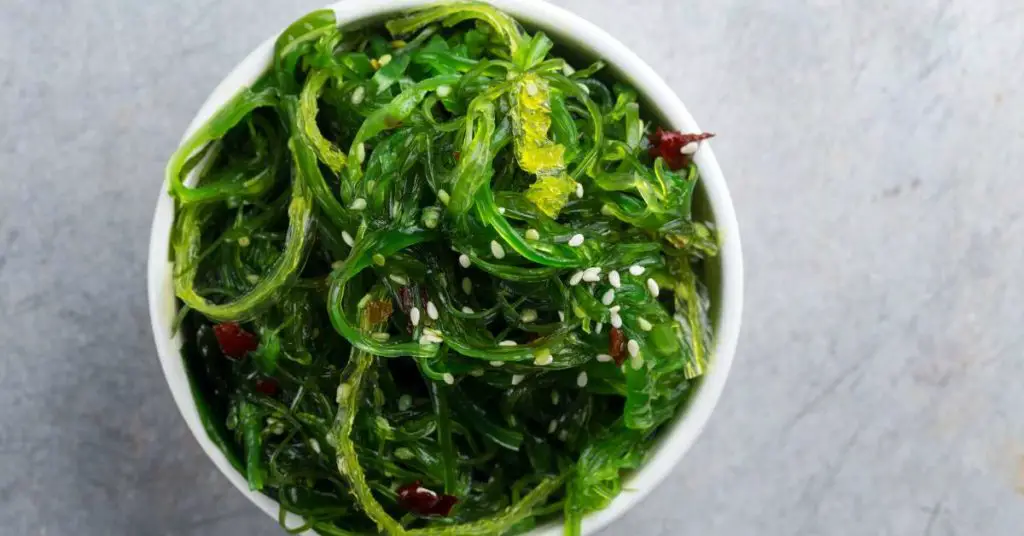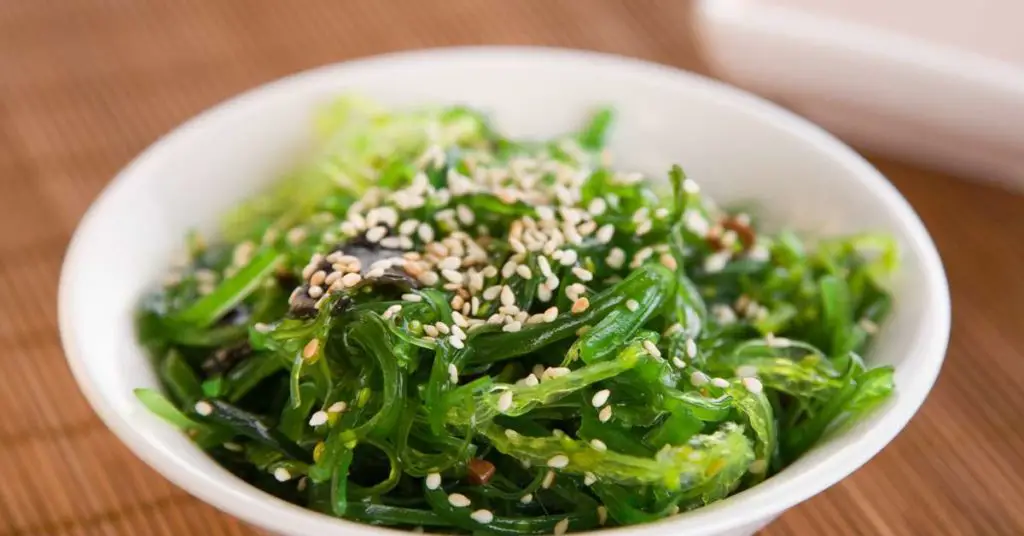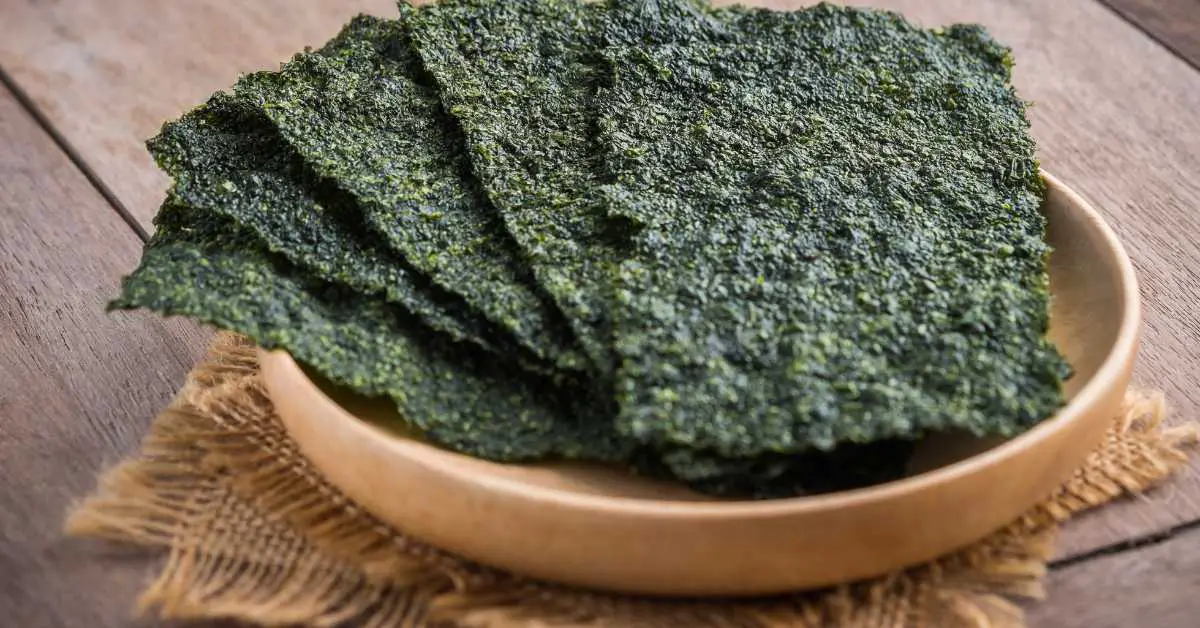Is seaweed low histamine? Before answering, you must know what it is. Seaweed grows in saltwater bodies like oceans and seas. This marine plant grows and thrives underwater and attaches itself to rocks or other surfaces with its root-like structures called holdfasts.
From delicate to sturdy, the plant comes in all shapes, sizes, and colors. Visit parts of Asia, especially Japan, and you’ll see it in dishes like sushi and seaweed salad or you might have enjoyed a cup of seaweed soup at some point in your life.
Seaweed adds flavor and vitamins, minerals, and antioxidants to dishes.
But it’s not just a one-trick pony. Apart from its culinary uses, you can also find seaweed in cosmetics, pharmaceuticals, and agriculture.
The Role Histamine Plays in Your Body
Now, for a quick review of histamine plays in your body and how histamine intolerance throws off your histamine balance.
Histamine plays many critical roles within our bodies. Immune cells, including mast cells, make this important chemical. You may also consume histamine when you eat certain foods, especially fermented foods. Histamine helps regulate vital functions like immune responses, digestion, sleep cycles, and even emotions.
Histamine also acts as a neurotransmitter or chemical messenger in your nervous system. Here, it allows cells to communicate with one another. When your body detects a threat, histamine signals white blood cells to increase blood flow and rush to the site, triggering an inflammatory response. This vasodilation effect enables your immune system to work efficiently against pathogens and foreign irritants to eradicate their threat.
Additionally, histamine influences the central nervous system in intricate ways. It modulates sleep-wake cycles, appetite signaling, and mood regulation. An imbalance of histamine is even thought to contribute to certain neurological conditions.
Histamine Intolerance Is Where Your Body Overreacts to Histamine
Some people don’t have enough of a key enzyme that breaks down histamine in the gut. This enzyme called diamine oxidase (DAO) helps clear histamine from your system.If you’re low on DAO, eating foods high in histamine can flood your systems and trigger a range of unpleasant symptoms known as “histamine intolerance.”
Reactions run the gamut from headaches and flushing to low blood pressure, anxiety attacks, hives and more. It’s like an allergic reaction that occurs when your histamine level goes up. Identifying and avoiding trigger foods provides relief for most.While histamine is clearly integral to many regulatory and protective processes, those with intolerances must be more careful with their dietary choices.
Being aware of personal tolerance levels and histamine contents in foods can help you manage your consumption. Overall, this compound plays a multifaceted, nuanced role within the body – at times vital, and for some, irritating. Finding the optimal balance is key.

Seaweed and Histamines
If you have histamine intolerance, the big question is whether seaweed contains histamine or not. Fortunately, seaweed itself is not a source of histamine.
Seaweed doesn’t naturally have histamine lurking in its green and leafy goodness. That’s good news if you’re trying to control your histamine intolerance symptoms.
As you know, histamine is a compound that, when it builds up, can cause the troubling symptoms you know of as histamine intolerance in susceptible individuals.
Some foods from the sea, like fish can build up high levels of histamine if they’re allowed to sit around too long.
Unlike some foods that might trigger histamine reactions, seaweed is chill in that department. So, if you’re someone who needs to be mindful of their histamine intake, it’s unlikely that adding histamine to your plate will trigger histamine intolerance symptoms.
There are sources online suggesting that certain types of seaweed, like nori, contain histamine, as they’re made from marine algae. I have found no study that shows this, and have not found from the people I’ve dealt with that consuming seaweed in moderation worsens histamine intolerance symptoms.
Be Mindful of How You Store and Prepare Seaweed
How you prepare and store seaweed could affect its histamine content. Sometimes, during storage or processing, histamine forms in certain foods, including seafood. This is because bacteria that produce histamine build up during storage to the point that the food can trigger histamine intolerance symptoms.
There’s no clear evidence that histamine builds up in seaweed during storage. However, I would store it in the refrigerator or freeze it to reduce the chance of histamine-producing bacteria gaining access to it.
Does Cooking Seaweed Affect Its Histamine Content?
Be aware that certain forms of cooking can increase the histamine content of seaweed. For example, a study found that frying seaweed boosted its histamine content by four-fold. (1)
If you cook seaweed, it’s best to boil it. However, you can enjoy seaweed raw too.
For example, you can use nori, a type of seaweed, as a wrap for other low-histamine foods. Nori is popular as a wrap for sushi, but you can wrap it around the foods of your choosing.
You can also grind seaweed with a grinder into flakes and use it as nutrient-rich seasoning for recipes. Another options is to add raw seaweed to low-histamine smoothies, soups, and stews.

Low-Histamine Seaweed Contains Nutrients Too
One of the benefits of eating seaweed is to supply your body with iodine. You need iodine for healthy thyroid function. Some sources say iodine is a histamine liberator, but this is unproven. In fact, there are claims on sites, like Reddit, that iodine blocks the conversion of histidine to histamine, thereby preventing histamine formation.
However, I couldn’t find a study that shows this. Other than iodized table salt, seaweed tops the list of iodine-rich foods. Seaweed also contains a variety of B-vitamins, vitamin A, vitamin C, and vitamin E. (3)
It’s also rich in the minerals your body needs to carry out essential chemical reactions that affect the health of your heart, nervous system, and more. When you eat a serving of seaweed, you get potassium, magnesium, calcium, and iodine.
Seaweed Is a Heart-Healthy Vegetable
Seaweed also contains soluble fiber, the form of fiber that supports heart health. (4, 5) Adding more soluble fiber to your diet also helps with blood sugar control and helps seed your gut with gut-friendly bacteria for a healthier gut microbiome. (3)
According to Harvard Health, adding more soluble fiber to your diet may help ward off other health problems, including type 2 diabetes and certain forms of cancer, including breast and colorectal cancer. (4)
Seaweed Has Potential Health Benefits Too
Also, intriguing are the possible health benefits of seaweed. One study found that seaweed harvested from the coast of Indonesia is rich in compounds called phenols and flavonoids that have antioxidant activity. (2)
Antioxidants help protect cells from oxidative stress that contributes to aging. Plus, they help reduce inflammation, making an antioxidant-rich diet potentially beneficial for histamine intolerance.
But be aware that seaweed can also be contaminated with heavy metals and other toxins when it comes from certain areas. So, don’t overdo it. (6)

Tips for Enjoying Seaweed Safely with Histamine Intolerance
- Choose fresh seaweed and use it quickly. Preferably, you want seaweed that was recently harvested.
- Store seaweed in the refrigerator to discourage the growth of bacteria that produce histamine. To avoid contact with air, store it in an airtight container.
- Keep a food dairy and monitor your symptoms if you add seaweed to your diet.
- Start with small amounts of seaweed and see how your body responds before eating large quantities.
Histamines in Seaweed
Is seaweed low histamine? Seaweed not only contains little or no histamine, it’s also a nutrient-rich sea vegetables with antioxidants and anti-inflammatory activity.
However, based on the study mentioned above, I wouldn’t fry it. Either enjoy it raw, add it raw to recipes, like soup, or boil it.
In a nutshell, seaweed is safe for most people with histamine intolerance. So, the next time you’re craving some seaweed salad or sushi rolls, go ahead and enjoy it, but monitor your symptoms to see how you respond. Also, find out more about fish oil and histamines.
In Summary
- Histamine is a compound that plays important roles in immune responses, digestion, sleep cycles, etc. But high levels can cause unpleasant symptoms in some people with histamine intolerance.
- Common high-histamine foods include aged/fermented products like cheese, wine, sauerkraut. Nori seaweed is generally not considered a high-histamine food.
- Research suggests nori seaweed contains lower histamine levels compared to other foods.
- Factors like processing method, storage conditions, seaweed species/origin can influence histamine levels in nori. Improper handling can increase histamine.
- For people following low-histamine diets, nori may be suitable in moderation. But those with severe intolerance/allergies should exercise caution and consult a healthcare professional first.
- Cooking/drying may increase histamine levels in nori slightly. Consuming fresh or lightly cooked may be preferable for sensitive individuals.
- Always keep a food diary, so you’ll know how consuming seaweed affects your mental and physical health.
As with any health issue, always consult with your personal physician about what to eat and not eat with histamine intolerance. Most people can tolerate nori seaweed, in moderation, without riggering histamine intolerance symptoms. It can also be a source of nutrients, including iodine.
But it’s important to take into account your overall health and other health conditions you might have when planning your low-histamine diet. If you’re unsure, a nutritionist who’s knowledgeable about histamine tolerance may be of help.
References:
- Chung BY, Park SY, Byun YS, Son JH, Choi YW, Cho YS, Kim HO, Park CW. Effect of Different Cooking Methods on Histamine Levels in Selected Foods. Ann Dermatol. 2017 Dec;29(6):706-714. doi: 10.5021/ad.2017.29.6.706. Epub 2017 Oct 30. PMID: 29200758; PMCID: PMC5705351. https://rb.gy/gbygp
- Gunji, S., Santoso, J., Yoshie-Stark, Y., & Suzuki, T. (2007). Effects of Extracts from Tropical Seaweeds on DPPH Radicals and Caco-2 Cells Treated with Hydrogen Peroxide. Food Science and Technology Research, 13, 275-279. https://doi.org/10.3136/FSTR.13.275.
- Rajapakse N, Kim SK. Nutritional and digestive health benefits of seaweed. Adv Food Nutr Res. 2011;64:17-28. doi: 10.1016/B978-0-12-387669-0.00002-8. PMID: 22054935.
- “Eat more fiber-rich foods to foster heart health.” 12 Jul. 2020, https://www.health.harvard.edu/heart-health/eat-more-fiber-rich-foods-to-foster-heart-health.
- McRae MP. Dietary Fiber Is Beneficial for the Prevention of Cardiovascular Disease: An Umbrella Review of Meta-analyses. J Chiropr Med. 2017 Dec;16(4):289-299. doi: 10.1016/j.jcm.2017.05.005. Epub 2017 Oct 25. PMID: 29276461; PMCID: PMC5731843.
- Hahn JL, Van Alstyne KL, Gaydos JK, Wallis LK, West JE, Hollenhorst SJ, Ylitalo GM, Poppenga RH, Bolton JL, McBride DE, Sofield RM. Chemical contaminant levels in edible seaweeds of the Salish Sea and implications for their consumption. PLoS One. 2022 Sep 23;17(9):e0269269. doi: 10.1371/journal.pone.0269269. PMID: 36149869; PMCID: PMC9506624. (PDF) Chemical contaminant levels in edible seaweeds of the Salish Sea and implications for their consumption (researchgate.net)

